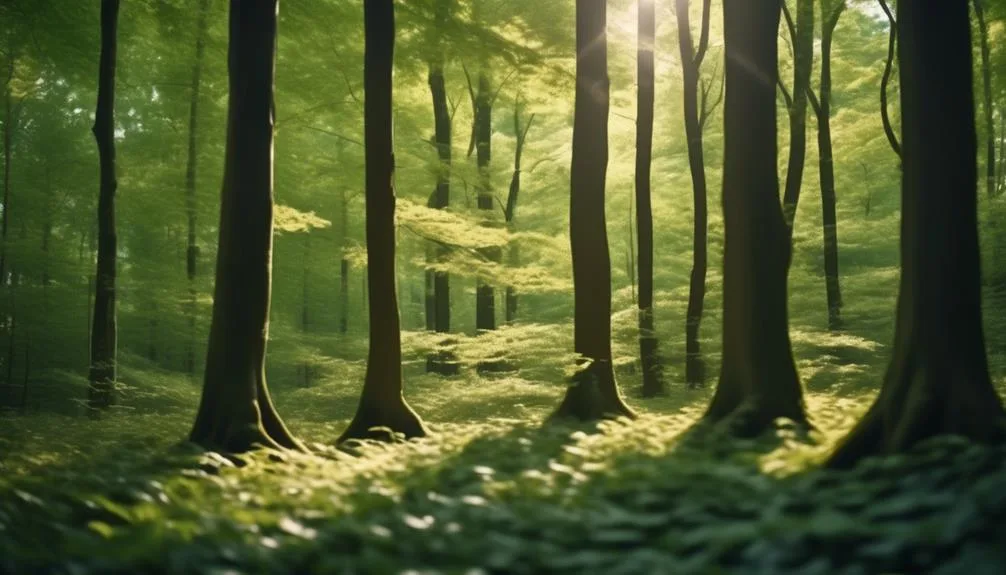Beech trees can actually do well in shaded areas, contrary to popular belief that they need full sunlight. Understanding how they adapt to different light conditions is crucial for their growth.
Exploring the challenges of growing beech trees in shade and the factors that affect their success is important. How exactly do beech trees cope in shaded areas, and what can be done to help them thrive?
Let's dive into the complexities of beech tree adaptation to shade and how to support their vitality in such conditions.
Light Requirements for Beech Trees
If you're considering planting beech trees, it's essential to understand their light requirements to ensure they thrive in their environment.
Beech trees are known for their shade tolerance, which means they can adapt and grow well in shady conditions. Despite their shade adaptation, beech trees still require some sunlight for photosynthesis, the process through which they produce food for growth.
In shaded areas, beech trees might grow more slowly compared to those in full sunlight, but they can still thrive. Understanding their shade tolerance and growth patterns will help you choose the right location to plant beech trees, ensuring they receive the right balance of sunlight and shade.
This knowledge will ultimately contribute to the successful growth and health of your beech trees.
Adaptability of Beech Trees to Shade
Shade tolerance is a key characteristic of beech trees, allowing them to thrive even in low-light conditions. Beech trees are highly adaptable to shade, making them ideal for woodland environments where sunlight is limited. Their ability to thrive in shade is attributed to their efficient photosynthetic process and their capacity to capture and utilize available light. Below is a table highlighting the shade tolerance of beech trees compared to other common tree species:
| Tree Species | Shade Tolerance |
|---|---|
| Beech | High |
| Oak | Moderate |
| Maple | Low |
| Pine | Very low |
| Sycamore | Moderate |
As shown in the table, beech trees exhibit high shade tolerance compared to other tree species, emphasizing their exceptional adaptation to low-light conditions.
Factors Affecting Beech Tree Growth in Shade
In shaded environments, beech tree growth is influenced by various factors that impact their ability to thrive and adapt to low-light conditions.
Beech tree competition plays a significant role in their growth in shade. When beech trees are surrounded by other vegetation, they compete for resources like water, nutrients, and light, which can affect their overall growth and health.
Additionally, shade tolerance is a crucial factor affecting beech tree growth. Some beech trees have higher shade tolerance than others, allowing them to better adapt to low-light conditions. This trait enables them to thrive in shaded environments where other species may struggle.
Understanding these factors is essential for managing and promoting healthy beech tree growth in shaded areas.
How to Support Beech Trees in Shady Environments
To support beech trees in shady environments, it's important to provide them with adequate access to essential resources and minimize competition from surrounding vegetation. Here are some key strategies to help your beech trees thrive:
- Monitor Soil Moisture: Ensure the soil around your beech trees maintains adequate moisture levels, especially in shady areas where water evaporation may be reduced. Consider mulching to help retain soil moisture and provide a healthy growing environment.
- Manage Canopy Competition: Regularly prune surrounding vegetation to reduce competition for sunlight, as beech trees in shady environments may struggle to reach sufficient light. This will help the trees access the light they need for photosynthesis and overall growth.
- Fertilize Appropriately: Supplement the soil with organic matter or a balanced fertilizer to provide essential nutrients for the beech trees, supporting their growth and resilience in shaded conditions.
Tips for Promoting Beech Tree Health in Shade
Enhance beech tree health in shaded environments by implementing targeted strategies to optimize their growth and vitality. While beech trees are shade-tolerant, promoting their growth in shaded areas requires specific care. Here are some tips to help you ensure the health and vigor of beech trees in shade:
| Tip | Description |
|---|---|
| Proper Pruning | Remove dead or crowded branches to allow sunlight penetration. |
| Adequate Watering | Ensure consistent and deep watering, especially during dry periods. |
| Mulching | Apply a layer of mulch around the base to retain moisture and deter weeds. |
| Fertilization | Use a balanced fertilizer to provide essential nutrients for growth. |
Conclusion
In nurturing beech trees with attention to light and soil, they can indeed thrive in shade. By understanding their needs and providing proper care, these trees can flourish, enriching your landscape with their beauty.
Consider the impact of creating a supportive environment for beech trees and how it contributes to the overall vitality of your surroundings.

My interest in trees started when I first saw the giant sequoias in Yosemite.
I was a teenager then, and I remember thinking, “I need to learn more about this.”
That moment stuck with me.
A few years later, I went on to study forestry at Michigan Tech.
Since graduating, I’ve worked in a mix of hands-on tree care and community education.
I’ve spent over ten years helping people understand how to plant, maintain, and protect the trees in their neighborhoods.
I don’t see trees as just part of the landscape.
They are living things that make a real difference in our daily lives.
